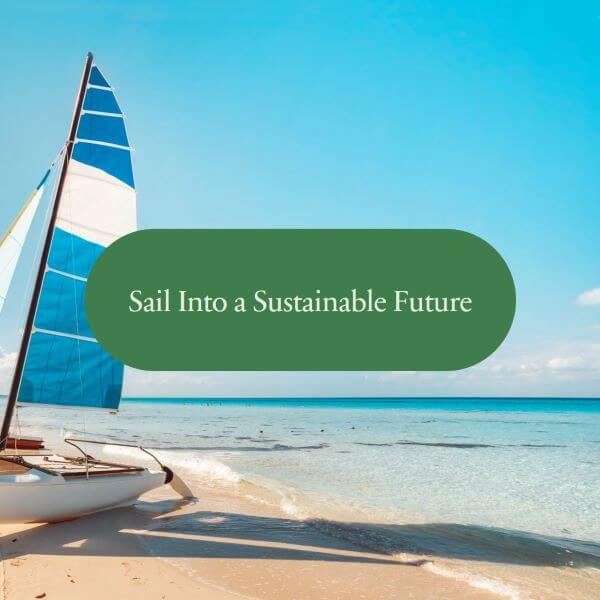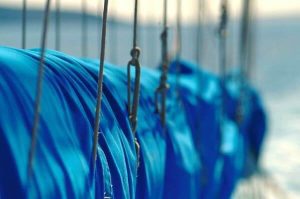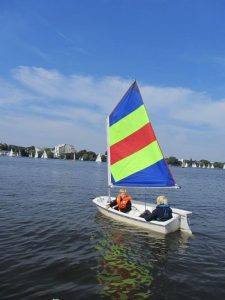Ever considered how your passion for sailing can harmonize with Mother Nature? Hop aboard as I chart a course through sustainable sailing – harnessing wind and sun, managing waste wisely, and respecting our aquatic neighbors. Discover why sailing green isn't just a trend, it's our future. Keep reading!
Table of Contents
- Key Takeaways:
- Introduction
- Understanding Sustainability
- Achieving Sustainable Maritime
- Renewable Energy Sources for Boats
- Sustainable Boat Design
- Wind Turbine
- Solar Panel
- Hydro Generators
- Waste Management on Board
- Conclusion
- Five Facts About Sustainable Sailing Practices:
- FAQs about Sustainable Sailing Practices
- What is sustainable sailing?
- What are some eco-friendly boating practices?
- How can renewable energy be used on sailboats?
- What are some sustainable anchoring techniques?
- How can waste be minimized on sailboats?
- What is the importance of reducing carbon footprint in sailing?
- Read our Latest Posts here:
Key Takeaways:
- Sustainable sailing practices promote the preservation of the marine environment and minimize negative impacts on marine ecosystems.
- Utilizing renewable energy sources such as wind turbines, solar panels, and hydro generators can significantly reduce reliance on non-renewable energy and decrease carbon emissions in the maritime industry.
- Implementing sustainable boat designs that prioritize energy efficiency, effective waste management, and eco-friendly materials helps in achieving a more sustainable maritime industry.

Introduction
Sustainable Sailing Practices: An Insight into Environmentally Friendly Navigation Techniques
Sailing has a tremendous impact on the environment, with certain practices causing harm to marine ecosystems. To address this issue, sustainable sailing practices have emerged as an important aspect of navigation. By adopting these practices, sailors can minimize their ecological footprint and ensure the longevity of our oceans.
The key to sustainable sailing lies in understanding the environmental impact of traditional navigation techniques and finding innovative solutions to mitigate them. This includes adopting renewable energy sources such as wind, solar, or hydro power to minimize the use of fossil fuels and reduce carbon emissions. Additionally, implementing efficient waste management strategies and adhering to strict recycling protocols can prevent pollution and preserve the delicate balance of marine ecosystems.
Another noteworthy aspect of sustainable sailing is the promotion of responsible tourism. This involves educating sailors and tourists about the need to respect marine life, avoid harmful anchorages, and support local conservation efforts. Emphasizing the importance of protecting coastal and marine habitats can contribute significantly to preserving these fragile ecosystems.
It is crucial for sailors to recognize that sustainable sailing practices are not only beneficial for the environment but also for their own recreational experience. By adopting these practices and actively engaging in environmental stewardship, sailors can enjoy the unparalleled beauty of the oceans while ensuring that future generations can do the same.
Pro Tip: As a responsible sailor, always stay updated on the latest sustainable sailing practices and technologies to continuously improve your environmental impact.
Understanding Sustainability
Sustainability: A Comprehensive Exploration
Sustainability can be understood as the pursuit of environmentally responsible practices that ensure long-term viability and balance. It encompasses responsible consumption, waste reduction, and renewable resource usage. By embracing a sustainable mindset, individuals and organizations can contribute towards creating a greener and more resilient future.
To achieve this, adopting practices such as recycling, energy conservation, and eco-conscious transportation can greatly help in reducing our carbon footprint and preserving the planet for future generations. It is crucial to recognize that understanding sustainability is not just a fleeting trend, but a necessary mindset shift that aims to create a harmonious coexistence between humans and the environment.
Achieving Sustainable Maritime
Achieving Maritime Sustainability
Sustainable maritime practices play a crucial role in ensuring the health and longevity of our oceans. By adopting environmentally friendly measures such as reducing emissions, minimizing waste, and promoting renewable energy sources, we can achieve sustainable maritime operations. These practices not only help preserve marine ecosystems but also contribute to the overall health of our planet.
Implementing sustainable maritime practices involves utilizing advanced technology and innovative solutions. For instance, the use of alternative fuels like biofuels and hydrogen can significantly reduce carbon emissions from ships, minimizing their environmental impact. Furthermore, optimizing routes and speeds can enhance fuel efficiency, lowering fuel consumption and decreasing greenhouse gas emissions.
To achieve sustainable maritime operations, it is essential to prioritize collaboration and knowledge-sharing among industry stakeholders. This includes fostering partnerships between governments, shipping companies, and environmental organizations to develop and implement effective strategies. Additionally, investing in research and development can lead to the creation of new technologies and materials that are more sustainable and eco-friendly.
One inspiring example of achieving sustainable maritime practices is the story of a shipping company that took a proactive approach to reduce its environmental footprint. By investing in fuel-efficient vessels, implementing onboard waste management systems, and collaborating with local communities for marine conservation efforts, the company successfully achieved sustainable operations and set a positive example for the industry.
Renewable Energy Sources for Boats
Renewable Energy Sources for Boats allow for sustainable sailing practices. Harnessing natural resources, such as solar and wind power, can provide a reliable and eco-friendly alternative to traditional fuel sources. These sources of renewable energy offer various benefits, including reduced emissions, decreased reliance on fossil fuels, and increased energy efficiency. Additionally, incorporating renewable energy systems on boats can lead to cost savings over the long term.
Some suggested practices for utilizing renewable energy sources on boats include:
- Installing solar panels - Solar panels can capture and convert sunlight into usable electricity.
- Wind turbines - Wind turbines harness the power of the wind.
- Hydro generators - Hydro generators utilize the motion of the boat through water to generate electricity.
By implementing these solutions, boaters can reduce their environmental impact while ensuring a reliable source of power on their journeys.
Sustainable Boat Design
Text: Sustainable Boat Design:
Boat sustainability is achieved through eco-friendly design techniques. It involves the use of renewable materials, energy-efficient systems, and environmentally conscious manufacturing processes. Adopting sustainable boat design not only reduces environmental impact but also promotes the conservation of natural resources.
In order to create a sustainable boat design, various factors need to be considered. This includes the careful selection of materials that minimize waste and energy consumption. Using composite materials, such as recycled fiberglass, can significantly reduce the carbon footprint of a boat. Additionally, implementing energy-efficient systems, such as solar panels or hybrid propulsion systems, further enhances the sustainability of the boat.
Moreover, sustainable boat design extends beyond the construction phase. Proper waste management systems, such as efficient sewage treatment and recycling programs, should be implemented to minimize pollution in the waterways. Additionally, incorporating eco-friendly practices in boat maintenance, such as using non-toxic cleaning products, helps to sustain the health of marine ecosystems.
By embracing sustainable boat design, boat owners and manufacturers can make a positive impact on the environment while enjoying their watercraft. Together, we can ensure the preservation of our natural resources for future generations. Don't miss out on the opportunity to contribute to a sustainable future by adopting these practices in boat design and maintenance.
Wind Turbine
Wind Turbine:
A wind turbine is a device that converts the kinetic energy from the wind into electrical power. It harnesses the natural power of the wind to generate clean and renewable energy.
- Wind turbines use large rotor blades to capture the energy of the wind and turn it into rotational motion.
- The rotational motion of the blades then drives a generator, which converts the mechanical energy into electrical energy.
- Wind turbines are typically installed in wind farms, where multiple turbines are grouped together to maximize power generation.
- They are designed to operate in areas with consistent and strong wind currents for optimal efficiency.
- Wind turbines play a crucial role in reducing carbon emissions and combating climate change by providing a sustainable source of energy.
Wind turbines are an essential component of the transition towards a greener and more sustainable future. Their efficient conversion of wind energy into electricity contributes to the reduction of greenhouse gas emissions and the preservation of our environment.
The history of wind turbines dates back centuries, with early designs being used for mechanical tasks such as grinding grain. However, the modern wind turbine that we know today began to emerge in the late 19th century with advancements in engineering and technology. From humble beginnings, wind turbines have evolved into sophisticated and efficient machines that play a vital role in our global energy landscape.
Solar Panel
Solar Panel is a sustainable energy device that converts sunlight into electrical energy. It consists of photovoltaic cells that capture sunlight and convert it into usable electricity.
- Efficiency: Solar panels have been continuously evolving to increase their efficiency in converting sunlight into electricity. Modern panels can now achieve high levels of efficiency, allowing for maximum energy production.
- Renewable Energy Source: Solar panels harness the power of the sun, which is an abundant and renewable energy source. Unlike fossil fuels, solar energy does not produce harmful emissions and reduces dependency on traditional energy sources.
- Cost-Effectiveness: Over the years, the cost of solar panels has significantly decreased, making them more affordable and accessible to homeowners and businesses. The long-term energy savings and incentives provided for solar installations make them a cost-effective investment.
- Environmental Benefits: Solar panels have a positive impact on the environment by reducing carbon emissions, mitigating climate change, and preserving natural resources. They help in reducing the carbon footprint and promoting a greener and cleaner future.
Solar panels play a crucial role in promoting sustainable energy practices and reducing reliance on non-renewable energy sources. Their widespread use contributes to a more environmentally friendly and economically viable future.
Solar panels have a rich history that dates back to the 19th century when the photovoltaic effect was discovered. The first practical solar cell was developed in the 1950s, paving the way for the modern solar panels we use today. Their continuous innovation and advancements have made solar panels an integral part of the renewable energy sector.
Hydro Generators
Hydro Generators play a significant role in sustainable sailing practices. They are an essential part of the sailing system, providing power through hydrokinetic energy. These generators harness the kinetic energy from flowing water to produce electricity, making them a reliable and eco-friendly source of power.
- Hydro generators are designed with advanced technology to efficiently convert water's kinetic energy into usable electricity.
- They are compact and lightweight, making them easy to install and integrate into sailing vessels.
- Hydro generators generate power silently and without emitting harmful emissions, making them a clean and quiet energy source.
- By utilizing the natural flow of water, hydro generators provide a sustainable and continuous source of power, reducing the reliance on fossil fuels.
To enhance their efficiency, hydro generators can be combined with other renewable energy systems, such as solar panels or wind turbines, creating a hybrid system for maximum power generation. This integration ensures a consistent power supply, even during low wind conditions or at night when solar energy is limited.
A true fact about hydro generators is that they have been successfully implemented in various sailing competitions, including the prestigious Vendée Globe race. These generators have allowed sailors to meet their energy needs while minimizing their environmental impact, showcasing their effectiveness and sustainability. (Source: Vendée Globe)
Waste Management on Board
Proper waste management on board is crucial for maintaining a sustainable sailing practice. Here are five key points to consider:
- Separation: Waste should be sorted into different categories like plastic, paper, and food waste to ensure efficient disposal.
- Recycling: Implementing a recycling program encourages the reuse of materials such as glass and aluminum cans, reducing waste volume.
- Composting: Organic waste can be composted onboard and used as fertilizers for plants and gardens on the ship.
- Incineration: Non-recyclable waste can be safely incinerated onboard using advanced technology to minimize environmental impact.
- Proper Disposal: Hazardous waste like chemicals and batteries should be handled and disposed of according to international regulations to prevent contamination.
To ensure comprehensive waste management on board, it is vital to consider unique factors such as the availability of recycling facilities, waste storage capacity, and crew training. Implementing efficient waste management practices not only reduces environmental impact but also promotes a sustainable and responsible sailing culture.
To further enhance waste management on board, some recommendations include:
- Minimize Packaging: Encourage suppliers to use eco-friendly packaging or reduce excessive packaging to decrease waste generation.
- Education and Awareness: Conduct regular training sessions for crew members to raise awareness about proper waste management practices and encourage their active participation.
- Sustainable Procurement: Choose eco-friendly and recyclable products while sourcing provisions for the ship to reduce waste production.
By implementing these recommendations and incorporating waste management practices into daily operations, ships can contribute significantly to the protection of marine ecosystems and promote sustainable sailing practices.
Conclusion
Sailing sustainably is an important practice for protecting our environment. By adopting eco-friendly techniques and using renewable energy sources, sailors can reduce their carbon footprint and preserve the beauty of our oceans. Sustainable sailing practices not only benefit the environment but also promote a sense of responsibility and stewardship among sailors. Conserving water, minimizing waste, and supporting local communities are additional ways in which sailors can contribute to a more sustainable future. It is crucial for sailors to recognize their role in preserving the marine ecosystem and take proactive steps towards sustainable sailing practices.
A true fact: According to the article "Sustainable Sailing Practices", adopting sustainable practices can lead to a significant reduction in carbon emissions and ultimately help mitigate the impacts of climate change.
Five Facts About Sustainable Sailing Practices:
- ✅ Sustainable sailing involves using renewable energy sources such as wind and solar power.
- ✅ By adopting sustainable sailing practices, sailors can minimize their carbon emissions while at sea.
- ✅ Boat design plays a crucial role in sustainable sailing, with lightweight constructions reducing power consumption and environmental damage.
- ✅ Wind turbines and solar panels are used to harness the natural energy sources of wind and sunlight, respectively, to power boats and minimize the use of fossil fuels.
- ✅ Waste management on board is an important aspect of sustainable sailing, with measures in place to minimize energy consumption, proper organization of waste, and minimizing plastic use.
FAQs about Sustainable Sailing Practices
What is sustainable sailing?
Sustainable sailing refers to the practice of sailing in an environmentally friendly manner, with a focus on minimizing the impact on the natural environment. It involves using sustainable and renewable energy sources, reducing waste and pollution, and respecting marine life and ecosystems.
What are some eco-friendly boating practices?
Eco-friendly boating practices include using renewable energy sources such as solar panels and wind power, minimizing waste on sailboats, using biodegradable boat cleaning products, practicing responsible sailing behavior, and participating in ocean cleanup initiatives.
How can renewable energy be used on sailboats?
Renewable energy sources such as solar panels and wind power can be used on sailboats to generate electricity. Solar panels convert the sun's rays into electricity, while wind power can be used for navigation and electricity generation. These sources help minimize the use of fossil fuels and reduce environmental damage.
What are some sustainable anchoring techniques?
Sustainable anchoring techniques involve choosing anchorages that minimize damage to marine habitats, such as avoiding sensitive areas like coral reefs. It also involves using environmentally-friendly anchoring gear, such as biodegradable anchor ropes, and practicing proper anchoring procedures to prevent damage to the seafloor.
How can waste be minimized on sailboats?
Waste on sailboats can be minimized by using electricity only for necessary equipment, minimizing the use of technological tools, properly organizing waste and keeping it away from the environment, using specific stations to empty the dirty water tank, and minimizing plastic use.
What is the importance of reducing carbon footprint in sailing?
Reducing carbon footprint in sailing is important because carbon emissions contribute to climate change and ocean acidification, which harm marine life and ecosystems. By minimizing carbon emissions through practices such as using renewable energy sources and reducing fuel consumption, sailing can be more environmentally sustainable.
Read our Latest Posts here:
- Royal Windermere Yacht Club ReviewDid you know Lake Windermere is England's biggest lake? It's 10.5 miles long and 1 mile wide. This beautiful lake is home to the famous Royal Windermere Yacht Club. It's one of the UK's top sailing clubs, making it a great spot for sailing fans and those who love being on the water. The Royal… Read more: Royal Windermere Yacht Club Review
- Coquet Yacht Club ReviewWelcome to the Coquet Yacht Club in Amble, UK. It's known for its yachting community and great marina. Also, see why this club is so well-loved. The Coquet Yacht Club has over 500 members who love boating. They come from many different backgrounds but share a passion for sailing. This club has a long history… Read more: Coquet Yacht Club Review
- Coniston Sailing Club ReviewDid you know about the Coniston Sailing Club in the stunning Lake District? It offers many services and activities for all sailing lovers. The club's beautiful location and great facilities make it a top pick for sailing in the UK. At Coniston Sailing Club, you can learn to sail, hire a boat, or join fun… Read more: Coniston Sailing Club Review
- St Andrews Sailing Club ReviewDid you know sailing is growing fast in the UK? More people are discovering the joy of sailing. If you love sailing or want to learn, check out St Andrews Sailing Club. The club has something for everyone. From beginners to experts, you can learn and have fun. Their instructors teach you everything about sailing… Read more: St Andrews Sailing Club Review
- Derwent Reservoir Sailing Club ReviewDid you know that Derwent Reservoir in Northumberland is famous for both calm walks and exciting water sports? The Derwent Reservoir Sailing Club is loved by many. Families, water sports fans, and those who love adventure come here. The club is in Blanchland, Consett, a nice place for all. Imagine paddle boarding, dinghy sailing, windsurfing,… Read more: Derwent Reservoir Sailing Club Review
- Loch Venachar Sailing Club ReviewWelcome to Loch Venachar Sailing Club, an exciting place! Loch Venachar is in the Trossachs National Park, a top spot in the Scottish Highlands for sailing fans. This club teems with beautiful sights and fun activities, making it a perfect spot for all. Join in the fun at Loch Venachar Sailing Club with sailing lessons… Read more: Loch Venachar Sailing Club Review
- Cardwell Bay Sailing Club ReviewDid you know that sailing is not just thrilling, but also helps you see the coast's beauty? It is well-loved by water lovers around the world. Cardwell Bay Sailing Club is here for you, offering amazing sailing adventures. The club is at the gorgeous Cardwell Bay marina. It's perfect for beginners and experienced sailors alike.… Read more: Cardwell Bay Sailing Club Review
- Clyde Corinthian Yacht Club ReviewDid you know the Clyde Corinthian Yacht Club is over 140 years old? Since 1877, this club on the west coast of Scotland has welcomed sailing fans. It's a place where both new and experienced sailors come together. The club is known worldwide for its excellence in sailing. The club has great facilities like a… Read more: Clyde Corinthian Yacht Club Review
- Ullswater Yacht Club ReviewThe Lake District isn't just about beautiful views. It's also a top place for sailing. Ullswater Yacht Club brings together sailing fans to enjoy the calm and excitement of sailing. It sits in the lovely Lake District. Here, you can join regattas, rent boats, or take sailing classes. This club is known for its great… Read more: Ullswater Yacht Club Review
- Prestwick Sailing Club ReviewDid you know over 1.5 million people in the UK love sailing and water sports? Among these, Prestwick Sailing Club is a top choice. It's on the beautiful Ayrshire coast. Here, you can enjoy various activities, no matter your skill level. The club offers sailing lessons, boat rentals, and a great clubhouse. It also hosts… Read more: Prestwick Sailing Club Review
- Clyde Cruising Club ReviewDid you know the Clyde Cruising Club started in 1909? It's one of Scotland's most respected sailing clubs in Scotland. For over a century, it has been central to the area's boating history and known for its wonderful sailing experiences. In the lively city of Glasgow, the Clyde Cruising Club is a key point for… Read more: Clyde Cruising Club Review
- Dalgety Bay Sailing Club ReviewOn the north shore of the Firth of Forth, about three miles east of the Forth Rail Bridge, you'll find Dalgety Bay Sailing Club nestled in its own spacious coastal area with a convenient high tide access harbour. The WyndDalgety BayDunfermlineFifeKY11 9SJ Author John Sixthsmith I'm a freelance writer and avid sailor who loves to… Read more: Dalgety Bay Sailing Club Review
- Royal Forth Yacht Club ReviewThe Royal Forth Yacht Club is a well-established water-sports club with over 150 years of history. Located in Granton Harbour near Edinburgh, the Club offers easy access to the beautiful sailing waters of the Firth of Forth. Members can participate in a variety of racing and cruising activities, with access to fully serviced moorings and… Read more: Royal Forth Yacht Club Review
- Port Edgar Yacht Club ReviewPort Edgar Yacht Club is situated in South Queensferry, near the iconic Forth Bridges, making it easily accessible within a 60-minute drive for most individuals in the Central Belt. Whether you are new to the area, have recently completed an RYA course, or simply wish to return to sailing, they are there to assist you.… Read more: Port Edgar Yacht Club Review
- Cramond Boat Club ReviewThe Cramond Boat Club is located at the mouth of the River Almond, just four miles from the bustling centre of Edinburgh. Our Clubhouse and moorings provide a welcoming home for a variety of small craft, from dinghies to small cruisers and motorboats. The River Almond offers tidal access to the Firth of Forth for… Read more: Cramond Boat Club Review
- Discover Dinghy Sailing Holidays Adventure!Are you ready for an unforgettable vacation experience? Imagine gliding across crystal-clear waters, feeling the wind in your hair, and exploring hidden coves and breath-taking coastlines. Dinghy sailing holidays offer a unique adventure that brings together the thrill of sailing with the serenity of being surrounded by nature. But what exactly are dinghy sailing holidays… Read more: Discover Dinghy Sailing Holidays Adventure!
- Experience the Majesty: Sailing Alaska AdventuresAre you ready to set sail and discover the untamed beauty of Alaska? Have you ever wondered what it's like to navigate through icy fjords, witness breathtaking wildlife, and experience the thrill of the open sea in one of the most awe-inspiring destinations on Earth? Get ready for an unforgettable adventure as we take you… Read more: Experience the Majesty: Sailing Alaska Adventures
- Set Sail on Learn to Sail Holidays AdventureAre you ready to embark on an unforgettable adventure and discover the thrill of sailing? Imagine mastering the art of navigating the open waters while exploring breathtaking destinations around the world. Whether you're a beginner or have some sailing experience, learn to sail holidays offer the perfect opportunity to embark on a new voyage of… Read more: Set Sail on Learn to Sail Holidays Adventure
- Greek Sailing Holidays – Unwind on the AegeanHave you ever dreamed of sailing through the turquoise waters of the Aegean Sea, exploring the enchanting Greek islands at your own pace? Picture yourself immersing in the captivating beauty of hidden coves, basking in the warm Mediterranean sun, and experiencing the rich cultural heritage that Greece has to offer. Well, it's time to turn… Read more: Greek Sailing Holidays – Unwind on the Aegean
- Understanding What Are Marine Conservation Areas: A GuideMarine conservation areas are protected ocean spaces designated to preserve marine environments and their inhabitants. These areas are established to help regulate human activities and promote sustainable practices that maintain the health and productivity of ocean ecosystems. Marine conservation areas play a crucial role in preserving marine biodiversity and protecting vulnerable species. By designating specific… Read more: Understanding What Are Marine Conservation Areas: A Guide
- Exploring Success Stories with Marine Conservation: Key InsightsIn recent years, marine conservation efforts have gained significant momentum, with organizations and individuals around the world taking action to restore the health of our oceans and protect marine life. In this article, we will delve into inspiring examples of marine conservation and showcase successful marine conservation projects through case studies and real-life stories. We… Read more: Exploring Success Stories with Marine Conservation: Key Insights
- Solutions Explored: What Can We Do About Marine ConservationOur oceans are essential for sustaining life on our planet, providing us with food, oxygen, and regulating our climate. However, our oceans face numerous threats such as overfishing, climate change, and pollution, which jeopardize the health and survival of marine life and the overall ecosystem. It's time we take action to protect our oceans and… Read more: Solutions Explored: What Can We Do About Marine Conservation
- Discover Who is the Father of Marine Conservation TodayEnvironmental preservation has become a pressing issue in recent times, with marine conservation at the forefront of efforts to protect our oceans and marine life. It is only through the tireless efforts of pioneers, trailblazers, and visionaries that we have come to understand the critical importance of preserving our planet's marine ecosystems. In this section,… Read more: Discover Who is the Father of Marine Conservation Today
- Understanding What Are Marine Conservation Zones: A GuideMarine ecosystems cover more than two-thirds of our planet and are an essential part of our lives. They provide us with food, oxygen, and countless other resources. However, human activities such as overfishing, pollution, and habitat destruction have put immense pressure on these ecosystems, threatening their health and sustainability. To address these issues, marine conservation… Read more: Understanding What Are Marine Conservation Zones: A Guide
- Understanding What is Marine Conservation: A Quick GuideMarine conservation refers to the protection and preservation of marine ecosystems and the species that inhabit them. It involves various efforts made by organizations and individuals to ensure the long-term sustainability of our valuable marine resources. Marine conservation strategies aim to reduce the negative impacts of human activities on marine ecosystems, such as overfishing, habitat… Read more: Understanding What is Marine Conservation: A Quick Guide
- Understanding What Are Marine Conservation Zones: A GuideMarine conservation is an important and growing field of work that aims to protect and preserve the health of our oceans and the species that inhabit them. With increasing awareness of environmental issues and the need for sustainable practices, the demand for professionals in the marine conservation sector is growing. If you are interested in… Read more: Understanding What Are Marine Conservation Zones: A Guide
- What is Blue Water Sailing? All you need to know.Blue water sailing is an exciting and challenging form of sailing that involves voyages across open waters, typically beyond the sight of land. It is a thrilling way to explore the vastness of the ocean, test your skills, and push your limits. Whether you are a seasoned sailor or someone who has never sailed before,… Read more: What is Blue Water Sailing? All you need to know.
- Is Blue Water Sailing Dangerous? Uncover the Truth Today!Embarking on a blue water sailing journey can be a thrilling experience, but it also comes with inherent risks. Long-distance sailing can be challenging and unpredictable, making it crucial to understand the potential hazards and prepare accordingly. In this section, we will explore the question of whether blue water sailing is dangerous. We will discuss… Read more: Is Blue Water Sailing Dangerous? Uncover the Truth Today!
- Exploring What Size Catamaran for Blue Water Sailing Is IdealPlanning a blue water sailing adventure requires careful consideration of various factors, including the size of the catamaran. The size of the catamaran plays a critical role in ensuring a comfortable and safe journey on the open ocean. But what size catamaran for blue water sailing is ideal? In this section, we will explore the… Read more: Exploring What Size Catamaran for Blue Water Sailing Is Ideal
- Easy & Non Messy Boat Snacks for Your Next Sailing Adventure!Welcome aboard, fellow sailors! As you prepare for your next adventure on the water, one thing you don't want to forget is snacks. However, the last thing you want is to deal with messy, crumbly snacks that leave a trail behind and attract unwanted bugs. That's why it's important to opt for non messy boat… Read more: Easy & Non Messy Boat Snacks for Your Next Sailing Adventure!
- Guide on What to Wear Dinghy Sailing for Comfort & SafetyAre you excited about your upcoming dinghy sailing adventure but unsure of what to wear? As a seasoned sailor, I understand the importance of comfortable and safe clothing while out on the water. In this section, I will provide you with a comprehensive guide on what to wear when going dinghy sailing, focusing on clothing… Read more: Guide on What to Wear Dinghy Sailing for Comfort & Safety
- Easy & Delicious Finger Food Ideas for Boating AdventuresWelcome aboard! No boating adventure is complete without some delicious and easy-to-eat finger foods. Whether you're cruising down the river or sailing into the sunset, having the right snacks is essential for a successful day on the water. If you're looking for some inspiration for your next boating trip, look no further. We've rounded up… Read more: Easy & Delicious Finger Food Ideas for Boating Adventures
- Is Dinghy Sailing Dangerous? Exploring the Risks & Safety TipsAs a professional journalist and avid sailor, I know that many people wonder whether dinghy sailing is a dangerous activity. After all, it involves navigating open waters in a small vessel, often in ever-changing weather conditions. While there are risks associated with any outdoor activity, I firmly believe that with proper precautions and skill, dinghy… Read more: Is Dinghy Sailing Dangerous? Exploring the Risks & Safety Tips
- Quick & Easy Meals to Cook on a Boat: Nautical Nutritious RecipesAre you planning a high seas adventure and looking for easy meals to cook on a boat? Look no further! In this section, we've compiled a selection of boat-friendly recipes that are hassle-free and packed with nutrients. These recipes are designed to be cooked with minimal resources and are perfect for those who want to… Read more: Quick & Easy Meals to Cook on a Boat: Nautical Nutritious Recipes
- Choosing What Thickness Wetsuit for Dinghy SailingAs a dinghy sailor, choosing the right wetsuit thickness is critical to ensuring your comfort and safety on the water. A wetsuit that is too thin or too thick can leave you feeling cold and cramped, making your sailing experience less enjoyable. In this article, I will provide a comprehensive guide on how to choose… Read more: Choosing What Thickness Wetsuit for Dinghy Sailing
- Essential Kitchen Utensils for Cooking While Sailing - Nautical GuideAre you planning a sailing adventure and want to enjoy delicious meals on board? Cooking in a sailboat kitchen can be challenging, but with the right tools, you can prepare tasty meals while enjoying the sea breeze. In this nautical guide, we will discuss essential kitchen utensils for cooking while sailing, so you can be… Read more: Essential Kitchen Utensils for Cooking While Sailing - Nautical Guide
- Understanding How Much Wind for Dinghy Sailing You Really NeedAs a dinghy sailor, it's important to understand how much wind is needed for an optimal sailing experience. Knowing the ideal wind conditions can help you optimize your speed and control while ensuring your safety on the water. Factors such as wind speed, direction, and gusts can all impact your dinghy sailing experience. It's important… Read more: Understanding How Much Wind for Dinghy Sailing You Really Need
- Discover Top Meal Planning Tips for Sailing Trips Today!Embarking on a sailing trip is an exciting adventure, but it's crucial to be well-prepared, especially when it comes to mealtimes. To fully enjoy your sailing experience, it's important to have a well thought out meal plan that takes into consideration the limited space, resources, and time available on a sailboat. In this article, we'll… Read more: Discover Top Meal Planning Tips for Sailing Trips Today!
- What is Dinghy Sailing - Discover the ThrillsAre you looking for a thrilling water sport that can take you on a wild ride? Look no further than dinghy sailing. It's an exciting activity that offers a unique challenge and a sense of adventure that few other sports can match. But what exactly is dinghy sailing? Let me explain. Dinghy sailing is a… Read more: What is Dinghy Sailing - Discover the Thrills
- Essential Guide to Must-Have Ingredients for Cooking on a BoatWelcome aboard, fellow travelers! If you're planning on cooking while on a boat or a yacht, you need to make sure you have the right ingredients. Cooking on a boat doesn't come without its challenges, and you need to be able to adapt to them. Whether you're a seasoned sailor or a first-time boater, this… Read more: Essential Guide to Must-Have Ingredients for Cooking on a Boat
- Must-Try Convenient Snacks for Sailing Excursions Guide!If you're planning a sailing excursion, you know how important it is to pack the right snacks. Whether you're heading out for a day trip or an extended journey, having convenient and delicious snacks on hand can make all the difference. In this guide, we'll explore a variety of snacks that are perfect for sailing… Read more: Must-Try Convenient Snacks for Sailing Excursions Guide!
- Discover Simple and Healthy Sailing Recipes for Your Next VoyageAre you planning your next sailing adventure and looking for easy and nutritious meal ideas to keep you energized on the water? Look no further than simple and healthy sailing recipes! These delicious recipes are not only easy to prepare but also packed with essential nutrients to keep you fueled all day long. In this… Read more: Discover Simple and Healthy Sailing Recipes for Your Next Voyage
- Discover the Best Food to Take on a Sailboat Trip: Your GuideEmbarking on a sailboat trip is an exciting adventure that requires careful planning, especially when it comes to food. The right food can make or break your trip, so it's crucial to consider what to pack and how to store it. In this guide, we'll cover all the essentials to ensure that you have the… Read more: Discover the Best Food to Take on a Sailboat Trip: Your Guide
- Relish Your Journey: Tasty Onboard Meal Ideas for Boating AdventuresWelcome aboard, fellow adventurers! There's nothing quite like the freedom and excitement of setting sail on the open water. Whether you're cruising the coastline or exploring new horizons, no boating trip is complete without delicious onboard meals. But who wants to spend hours cooking in the galley when there are waves to catch and sights… Read more: Relish Your Journey: Tasty Onboard Meal Ideas for Boating Adventures
- Whip Up Delicious Meals for Sailboat Trips: An Easy GuideBon voyage! Sailing trips are an adventure waiting to be explored. The thrill of the open water, the wind in your hair, and the horizon stretching out before you are simply unbeatable. However, what's a sailboat trip without delicious meals? Onboard dining should be as much a part of your sailing experience as the beautiful… Read more: Whip Up Delicious Meals for Sailboat Trips: An Easy Guide
- Which Sail to Raise First?In sailing, you generally raise the mainsail first. This provides better control over the boat's movement and balance. You should be aware though that different conditions and types of boat may require specific sail raising procedures. Sailing is an exhilarating and intricate activity that requires careful attention to detail and proper sail handling. Here you… Read more: Which Sail to Raise First?
- Why is Marine Conservation Important?Marine conservation is vital to preserve biodiversity, ecosystems, mitigate climate change, ensure food supplies, support coastal communities, and safeguard the planet's oxygen production. Simply, it's crucial for the survival of marine life and humanity. Introduction: Why Marine Conservation Matters More Than Ever The ocean waves crash against the shore, seafoam swirling as the tide goes… Read more: Why is Marine Conservation Important?
- Sustainable Sailing PracticesEver considered how your passion for sailing can harmonize with Mother Nature? Hop aboard as I chart a course through sustainable sailing – harnessing wind and sun, managing waste wisely, and respecting our aquatic neighbors. Discover why sailing green isn't just a trend, it's our future. Keep reading! Key Takeaways: Introduction Sustainable Sailing Practices: An… Read more: Sustainable Sailing Practices
- Bartley Green Sailing Club ReviewKey takeaways: Introduction Bartley Sailing Club offers a comprehensive review of its facilities and services. Discover the club's offerings and amenities through this informative article. Delve into the details of Bartley Sailing Club's features, ensuring you have all the necessary information before making a decision. Additionally, incorporating the provided Pro Tip will enhance your Bartley… Read more: Bartley Green Sailing Club Review
- Are Sailing Lessons Worth It?In my opinion sailing lessons are a great investment! Whether you want to be a seasoned sailor or simply have fun, learning this maritime skill can open up lots of possibilities. You'll understand wind patterns, how to navigate tricky waters, and gain boat dynamics knowledge. This maritime skill is more than what meets the eye!… Read more: Are Sailing Lessons Worth It?
- What does rough sailing ahead mean?
- Gill Sailing BootsGill Sailing Boots - The Best Choice for the Seas! Sailors everywhere recognize the importance of reliable gear. To conquer the unpredictable seas, a trusty pair of sailing boots is essential. Gill Sailing Boots are a top choice for sailors worldwide. I have to say that the first pair of Gill Sailing Boots I ever… Read more: Gill Sailing Boots
- Why do Sailing Boats have Two Wheels?Majestic sailing boats, with their billowing sails, are a sight to behold. But why do they have two wheels? It is for their intricate mechanics and design. These boats sail through the sea and two wheels make them easier to maneuver and control. These two wheels are called helms or steering wheels and are usually… Read more: Why do Sailing Boats have Two Wheels?
- Do you Wear Socks with Sailing Boots?I wear socks with my sailing boots for reasons of comfort and because the smell gets really bad if I don't. That said I never look as trendy or cool as others, but I sail because I enjoy it, I never look like I'm about to do a photoshoot for Tatler magazine. A little further… Read more: Do you Wear Socks with Sailing Boots?
- Why are Sail Covers Blue?Sail covers are often blue due to the color's practical advantages: blue reflects sunlight, reducing UV damage and heat absorption, and it also hides dirt and stains well, given the marine environment. For a full explanation about it and other related topics read on. Introduction to Blue Covers Sail covers are mostly blue due to… Read more: Why are Sail Covers Blue?
- Why is Sailing Expensive?Sailing is costly due to high initial investment (boat, safety gear), maintenance costs, docking fees, and fuel. Additionally, sailing lessons, insurance, and potential repair costs add to the expenses. Not to mention the value of time spent in learning and practice. Is it expensive to go Sailing? Yes, going sailing can be expensive. Costs include… Read more: Why is Sailing Expensive?
- Junior Sailing GearGet the latest scoop on junior sailing gear with our 2023 guide. We've combined safety and style to help young sailors navigate with confidence. From UV protection gear and durable wetsuits to stylish sunglasses, discover the essentials for your child's sailing adventure. Key Takeaway: Junior Sailing Gear: What You Need to Know When it comes… Read more: Junior Sailing Gear
- Foul Weather Gear LockerIntroduction to Foul Weather Gear Locker When it comes to braving the elements, a well-stocked foul weather gear locker is an essential asset. A carefully curated collection of top-quality jackets, pants, boots, and accessories can make all the difference in keeping you dry and comfortable. With waterproof materials, reinforced seams, and adjustable features, foul weather… Read more: Foul Weather Gear Locker
- Do you need a visa when sailing?Introduction Planning a sailing adventure? Wondering if you need a visa? Let's dive into the world of sailing and find out the nautical requirements. We'll explore the ins and outs of visas, ensuring your voyage is smooth sailing from start to finish. Setting sail on azure waters beckons those who seek an escape from the… Read more: Do you need a visa when sailing?
- Why are Sails Black in Sydney to HobartBlack sails are often used in Sydney to Hobart races due to their UV-resistant properties. Carbon or Kevlar laminates are UV-stable, which reduces wear over the course of a long race, and these materials are typically black. If you read on I'll give far more information on black sails and why they're so popular. Introduction… Read more: Why are Sails Black in Sydney to Hobart
- Is Sailing a Dying Sport?Yes it is and without more TV coverage of events we are not going to attract new sailors. Discover the truth about the future of sailing and explore its potential decline in this article on sailing's viability. Key Takeaway: The Decline of Sailing as a Sport Over the years, there has been a noticeable drop… Read more: Is Sailing a Dying Sport?
- Tips for Sailing in Cold WeatherLearn to navigate the chill with our comprehensive guide. Explore essential tips for safe and successful cold-weather sailing. Conquer the icy waters today! Key Takeaways: Stay Dry As an avid sailor, I know the importance of staying warm and dry while out on the water in cold weather conditions. That's why in this section, we'll… Read more: Tips for Sailing in Cold Weather
- Quantum Sailing GearI believe that the best way to enjoy sailing is to be prepared for anything. With Quantum sailing gear I always feel that I am. They have a wide range of top quality sailing gear, such as hats, gloves and foul weather gear. Introduction to Quantum Sailing Gear Sailing has been an integral part of… Read more: Quantum Sailing Gear
- Sailing Clothing QubaSailing clothing Quba - Explore Quba's high-end clothing, merging function and fashion for the modern sailor. Discover maritime style that's looks good and lasts. Key Takeaways: Introduction Sailing Gear for Optimal Performance Sailing clothing is an essential component of any sailor's equipment, ensuring optimal performance in harsh weather conditions. Quba's line of sailing clothes is… Read more: Sailing Clothing Quba
- What is the Best Sailing Racing Tip?The best sailing race tip is to always maintain optimal trim. A well-trimmed sailboat will be faster and more efficient, keeping you competitive in a race. This involves constant adjustments to the sails and rigging in response to wind shifts and changes in boat speed. TLDR Apart from the above this article covers the following;… Read more: What is the Best Sailing Racing Tip?
- How much it costs to start sailing?Explore the financial aspects of starting your sailing journey. From boat purchase to maintenance costs, I break down everything you need to set sail. Based on my experience I cover all you need to know. TLDR: Sailboat Prices When it comes to sailing, one of the first questions that pop up in the mind is,… Read more: How much it costs to start sailing?
- How to start sailing if based in LondonSailing Courses in London: An Overview Finding theory courses in London isn't so difficult but actually getting on the water for practical lessons is another matter. If you are keen to learn how to sail then great but you'll need some determination to hunt out the courses you'll need. I'd suggest you check out the… Read more: How to start sailing if based in London
- Can you sail from the black sea to the Mediterranean?Introduction Voyaging from the Black Sea to the Mediterranean is a much-coveted journey. Its tricky route necessitates a thorough understanding of navigation due to its complex landscape, strong winds, and possible security hazards. The Bosphorus Strait unites the Sea of Marmara and the Black Sea, while the Dardanelles connects the Aegean Sea and Marmara. A… Read more: Can you sail from the black sea to the Mediterranean?
- What are your favorite meals to prepare and eat while sailing?Key points: Essential Foods to Bring on a Sailing Trip As an experienced sailor, I always make sure to pack essential foods for my trips. Bringing the right kind of food not only ensures that our tastebuds are satisfied, but also helps us stay energized and healthy while at sea. In this segment, we take… Read more: What are your favorite meals to prepare and eat while sailing?
- What is the oldest active sailing boat?The oldest active sailing boat is believed to be the "Star of India." The Star of India is a fully rigged iron-hulled ship that was built in 1863. Originally known as the Euterpe, it was used for transporting emigrants to New Zealand and then served as a cargo ship in various trades, including the jute… Read more: What is the oldest active sailing boat?
- What's the Biggest Difference between Freshwater Sailing and Ocean going Sailing?The quick answer? Ocean sailing has sheer scale and unpredictability added into the mix. With larger bodies of water, stronger winds, tidal influences, ocean sailing is the ultimate challenge, while freshwater sailing tends to offer more controlled and smaller-scale experiences. In this article you will discover the contrasting worlds of freshwater sailing and ocean-going sailing… Read more: What's the Biggest Difference between Freshwater Sailing and Ocean going Sailing?
- How did Sailing Ships Repair their Masts at Sea?Introduction Sailing ships had to battle many difficulties on the seas, like repairing their masts, which was no easy task. To do this, they'd make a 'jury mast' with spare wood from the ship. Or they'd fix a pole across the deck and hoist the broken mast for repair. Some captains even had pre-made masts… Read more: How did Sailing Ships Repair their Masts at Sea?
- Sailing as an Overweight PersonExplore the unique challenges and rewards of sailing as an overweight individual, in my comprehensive guide. When I started sailing I was about 60lbs heavier than I am now so I've real world experience of sailing as an overweight person. Discover how to navigate issues of safety and comfort on the boat, understand the potential… Read more: Sailing as an Overweight Person
- Are Crocs good for Sailing?Introduction Sailors often seek the best footwear for their nautical journeys. Crocs are a popular choice due to their slip-resistant soles and comfortable design. They're perfect for keeping feet dry and safe on wet surfaces. Plus, they're easy to clean. Some sailors say they even provide more traction than boat shoes. But, you must be… Read more: Are Crocs good for Sailing?
- How much do you tip a sailing instructorHow much to tip a sailing instructor: A guide Tipping your sailing instructor is a must! But, how much to give? Here's a guide general guide firstly, then I look at it depending whether you're in the USA, UK or Australia. General Considerations on Tipping Sailing Instructors Remember, it's about the unique boating experience and… Read more: How much do you tip a sailing instructor
- Is sailing in Belize safe?In my opinion "Yes it is". Belize has a lot to offer and a few sensible precautions will give you a great sailing trip. The reputation it got for having issues with pirates got blown out of all proportion in my view, it certainly wouldn't stop me from sailing there, it's a beautiful place. Overview… Read more: Is sailing in Belize safe?
- Why are triangular sails betterWhy are triangular sails better? Read this to discover the undeniable advantages of triangular sails and explore their efficiency, giving optimal performance at sea. The Benefits of Triangular Sails Triangular sails have some great advantages over other sail shapes. They provide improved speed, better manoeuvrability, and control. Benefits include: What else? Triangular sails will keep… Read more: Why are triangular sails better
- What is the sailing capital of the worldWhat Makes a Destination the Sailing Capital of the World? What makes a place the "sailing capital of the world"? Geography and topography of the coast must be suitable. Plus, having wonderful port amenities is important too. To back it up, lots of sailing events, experiences and good infrastructure are needed. But culture is the… Read more: What is the sailing capital of the world
- How hard is sailing?How hard is sailing? Embark on a journey through the challenges of sailing as you explore the learning curve and valuable lessons in this captivating post. Dip your toe, into sailing waters When a beginner joins their local sailing club and embarks on their first lessons, they can expect to learn a variety of the… Read more: How hard is sailing?
- How did sailing ships survive stormsChallenges faced by sailing ships during storms Discover the remarkable resilience of old sailing ships as they confronted treacherous storms, here I unveil the tactics that helped them survive and prevail. Sailing ships in days gone by had to deal with the perils of storms at sea, without any of the modern day aids sailors… Read more: How did sailing ships survive storms
- Is sailing a Dangerous Sport?Yes, but it's the element of risk that brings excitement and adventure to the sport. Embrace the challenge, to test your skills against the might of the sea. Face up to the thrilling challenge of sailing, a sport that tests your abilities. Learn how to harness the wind and navigate the seas, mastering the art of… Read more: Is sailing a Dangerous Sport?
- How far can you sail in a day?Embark on a nautical adventure as we delve into the limits of daily sailing limits. Discover the farthest reaches of untapped potential of sailing in a single day. You can sail about 140 nautical miles in a full 24 hour period. Though I generally used to take things a little easier unless I was racing.… Read more: How far can you sail in a day?
- How long does it take to learn sailing?Discover the journey to mastering sailing, explore the timeline and factors involved. Novice to captain, find out how long it takes to learn the art of sailing. Key Takeaways: Time Required to Learn to Sail I've always been fascinated by sailing and wanted to learn it for years now. One thing that always held me… Read more: How long does it take to learn sailing?
- What age to start sailing?Discover the ideal age to start sailing and embark on a nautical adventure. Explore the benefits and considerations for beginners in this insightful article. Key Takeaways: Introduction to Youth Sailing Sailing at a youth age is an excellent way to introduce children to the sport and instill skills that they can use throughout their life.… Read more: What age to start sailing?
- How fast were old sailing ships?Key Takeaway: Introduction Sailing Ships: How Fast Were They? Sailing ships have always been an essential means of transportation and trade across the seas. Delving into the history of these ships brings light to their speed capabilities. When it comes to measuring the speed of these ships, the knot is the unit of measure. The… Read more: How fast were old sailing ships?





















































































